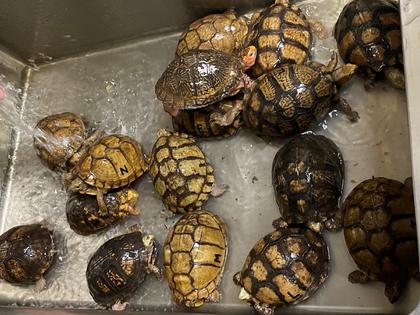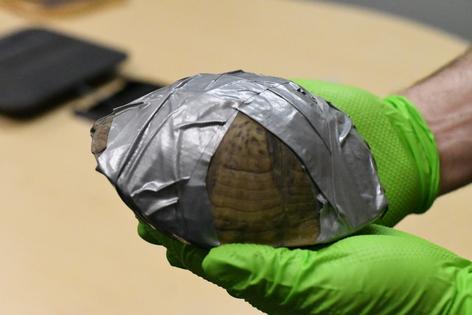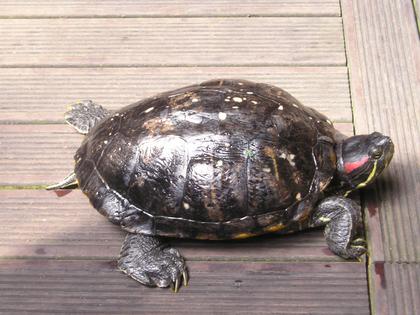There's a thriving global market in turtles, and much of that trade is illegal
Published in News & Features
Hatchling turtles are cute, small and inexpensive. Handled improperly, they also can make you sick.
Turtles are well-known carriers of salmonella, a common bacterial disease that causes fever, stomach cramps and dehydration and can lead to severe illness, especially in young children and elderly people. In August 2023, the Centers for Disease Control and Prevention released an advisory about an 11-state outbreak of salmonella bacteria linked to pet turtles.
“Don’t kiss or snuggle your turtle, and don’t eat or drink around it. This can spread Salmonella germs to your mouth and make you sick,” the agency warned.
Global trade in turtles is big business, and the U.S. is a leading source, destination and transit country. Some of this commerce is legal, some is not. For example, it has been illegal in the U.S. since 1975 to sell turtles with shells less than 4 inches (10 centimeters) in diameter because young children often contract salmonella from them. But it’s easy to find them for sale nonetheless.
However, humans are a much bigger threat to turtles than vice versa. Over half of the world’s turtle species are classified as threatened or endangered, and overharvesting of wild turtles is a major cause. Turtles also face other threats, including habitat loss, climate change, pollution, diseases, invasive species and death or injury while trying to cross roads.
As a conservation biologist, I work with colleagues from academia, nonprofit organizations and state and federal agencies to protect threatened species and combat wildlife trafficking. I also use the global wildlife trade to teach important ecological concepts and research skills. Here’s what we know about trade in turtles and how it threatens their survival.
It’s hard to harvest turtles sustainably because they are so long-lived. Individual turtles of some species can survive for more than 100 years. Most turtles reach reproductive maturity late in life and have relatively few eggs, not all of which produce successful offspring.
To put this in context, compare a common female snapping turtle from the northern U.S. with a female white-tailed deer. Begin at the start of their lives and fast-forward 17 years. At this point, the snapping turtle will just be ready to reproduce for the first time; the deer will already be dead, but it may have produced over 600 descendants. It can take a female turtle her entire life to generate one or two offspring that in turn reach adulthood and replace her in the population.
Turtles are valuable because they play diverse roles in land, freshwater and ocean ecosystems. For example, tortoise burrows provide refuge for hundreds of other species, including birds, mice, snakes and rabbits. Box turtles – the type you may encounter in your garden – consume practically any kind of plant material and excrete the seeds as they move around, helping plants spread. Some seeds even germinate more readily after passing through a box turtle’s gut.
In lakes and ponds, freshwater turtles serve as both predator and prey, and they help maintain good water quality by consuming decaying organisms. Terrapins reside in brackish water zones, where rivers flow into oceans and bays, and feed heavily on snails. Without terrapins present, the snails would quickly consume all underwater seagrasses, which would harm fish, shellfish, sea urchins and other organisms that rely on seagrasses for their survival.
Humans have long been fascinated with turtles. Revered in many cultures, turtles have symbolized strength and longevity for centuries. Today, people use turtles as pets; sources of food, jewelry and other curios; and in traditional medicines and religious and cultural practices.
International trade in turtles takes place on a massive scale. According to the U.S. Fish and Wildlife Service, nearly 127 million turtles were exported just from the U.S. between 2002 and 2012. About one-fifth (24 million) came from the wild.
More recent data indicates that exports declined between 2013 and 2018, but trade in particular species increased. Commercial freshwater turtle farming is still a multimillion-dollar industry in the southeastern U.S.; a small number of native turtle species, largely bred on turtle farms, now make up the bulk of legal U.S. exports, for use as both pets and food.
There’s no good way to quantify how many native turtles are harvested from the wild. But history shows what happens when they are hunted without limits. Historic demand for sea turtles, diamondback terrapins and snapping turtles as food led to such crashes in populations that management agencies had to regulate their harvesting.
Turtles also are gaining popularity as pets, particularly for younger adults. Surveys indicate that more than 2 million Americans own turtles. To curb pressure on wild populations, state agencies are prohibiting or limiting personal collection and possession of native turtles.
Despite existing regulations, demand for some native North American turtle species is so strong that people collect, smuggle and sell the animals illegally. For example, in 2019 a Pennsylvania man was sentenced to six months in prison and fined $250,000 for trafficking thousands of protected diamondback terrapins.
Rare species such as wood turtles and Blanding’s turtles, as well as uniquely patterned individual turtles, command top value on the black market. Internet commerce, social media apps and online payment mechanisms make it easy for illegal buyers and sellers to connect.
Between 1998 and 2021, U.S. enforcement agencies intercepted at least 24,000 protected freshwater turtles and tortoises from 34 native species that were being illegally traded across the U.S. These animals may be held without food and water and in crowded spaces, sometimes wrapped in tape and stuffed in socks.
To curtail the illegal turtle trade, regulators are working to strengthen regulations and increase enforcement. Private citizens can also help reduce the demand and protect wild turtles. Here are some simple steps:
Before you purchase any live animal or wildlife-related product, review relevant local, state, national and international regulations. Just because something is for sale doesn’t mean it’s legal.
Make an informed decision about owning a turtle. Consider the size it will reach as an adult, its care requirements and its life span. Prioritize adopting one from a reputable rescue organization, and seek out a captive-bred turtle instead of a wild one.
Don’t release an animal that you no longer want or can’t care for into the wild. This is illegal and can have serious ecological impacts. The red-eared slider (Trachemys scripta elegans), a freshwater turtle that’s native to the Mississippi River basin, was sold by the millions in recent decades and released by many pet owners. Now it is considered one of the world’s most invasive species because it outcompetes native turtles for food and space.
If you encounter illegal wildlife collection, smuggling or sales, report them to your state fish and wildlife agency or the U.S. Fish and Wildlife Service for investigation.
Support efforts to conserve and restore turtle habitat and minimize other threats, such as pollution and road traffic.
This article is republished from The Conversation, an independent nonprofit news site dedicated to sharing ideas from academic experts. The Conversation has a variety of fascinating free newsletters.
Read more:
Turtles on the tarmac could delay flights at Western Sydney airport
More people eat frog legs than you might think – and humans are harvesting frogs at unsustainable rates
Jennifer Sevin is a co-founder and serves on the steering committee of the Collaborative to Combat the Illegal Trade in Turtles.













Comments